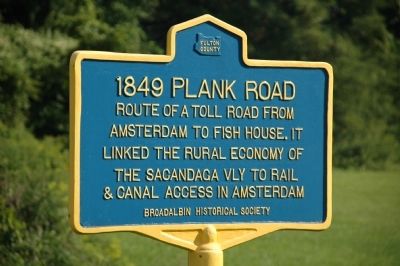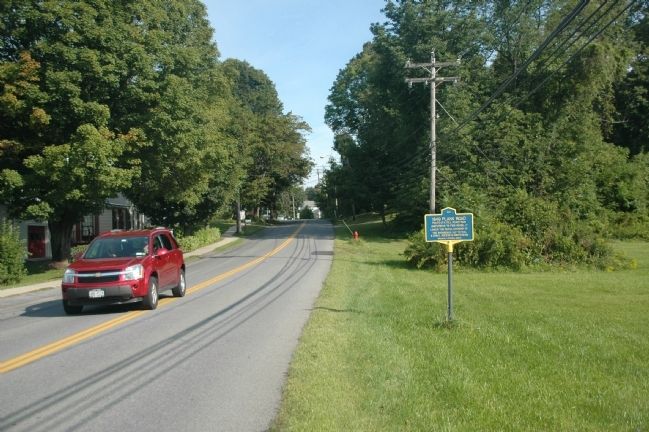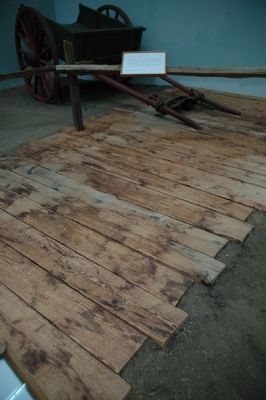Broadalbin in Fulton County, New York — The American Northeast (Mid-Atlantic)
1849 Plank Road
Amsterdam to Fish House. It
linked the rural economy of
the Sacandaga Vly to rail
& canal access in Amsterdam
Erected by Broadalbin Historical Society.
Topics. This historical marker is listed in these topic lists: Industry & Commerce • Roads & Vehicles.
Location. 43° 3.33′ N, 74° 12.022′ W. Marker is in Broadalbin, New York, in Fulton County. Marker is on South 2nd Ave, 0.1 miles south of West Main Street (County Road 155), on the left when traveling south. Touch for map. Marker is at or near this postal address: 17 South 2nd Ave, Broadalbin NY 12025, United States of America. Touch for directions.
Other nearby markers. At least 8 other markers are within walking distance of this marker. Hotel Broadalbin (about 600 feet away, measured in a direct line); Broadalbin World War Two Memorial (approx. ¼ mile away); In Honor/Dedicated/Gratitude (approx. 0.3 miles away); Kennyetto Creek (approx. 0.3 miles away); 1879 Fire (approx. 0.3 miles away); Johnson Hall - 1763 (approx. 0.3 miles away); In Honor (approx. 0.3 miles away); Veterans Hall (approx. 0.3 miles away). Touch for a list and map of all markers in Broadalbin.
Regarding 1849 Plank Road. Hamilton County—The Amsterdam and Fish-house road, 16 miles in length, opens a communication from this thinly populated county to the Schenectady and Utica Railroad. This plank road is to be continued to a village named Northville, six miles further; and although only opened last fall, has already had considerable influence on property. The business of the tanneries has already increased, owing to the greater facility of carting hides and taking leather to market. Three new tanneries are now in operation on the line. The value of land on and near the road has increased 20 per cent. Owing to the woodlands in Hamilton county thus becoming accessible, they have risen greatly in value. Several new saw-mills have been erected, and lumber at the mill, without regard to the market price, is rated at a higher price. Previous to the road being planked, these lands had no sale. They are now brought into the market—the attention of people is directed to them. Owners are beginning to look up long neglected tracts, and are setting guards to see that the trees are not cut, and that trespasses are not committed. The average value of farm land is about $8, and farmers have commenced to pay much more attention to them, since an avenue has been opened for their produce.
- From the book, Plank Roads, in the United States and Canada by William Kingsford, 1851
Also see . . .
1. Broadalbin in History - Era of Development 1815-1860. (Submitted on September 13, 2011, by Howard C. Ohlhous of Duanesburg, New York.)
2. Heritage & Culture Historic Markers: 1849 Plank Road. (Submitted on December 8, 2019, by Howard C. Ohlhous of Duanesburg, New York.)
Credits. This page was last revised on December 12, 2019. It was originally submitted on September 13, 2011, by Howard C. Ohlhous of Duanesburg, New York. This page has been viewed 654 times since then and 16 times this year. Photos: 1, 2, 3. submitted on September 13, 2011, by Howard C. Ohlhous of Duanesburg, New York. • Bernard Fisher was the editor who published this page.


